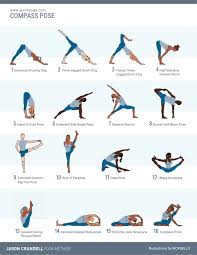The Benefits of Practicing Yoga Poses
Yoga is a practice that has been around for centuries, offering a wide range of physical, mental, and emotional benefits. One of the key components of yoga practice is performing various poses, also known as asanas. These poses not only help improve flexibility and strength but also promote relaxation and overall well-being.
Improved Flexibility
One of the most obvious benefits of practicing yoga poses is improved flexibility. Regularly performing asanas helps stretch and lengthen muscles, making them more supple and reducing the risk of injury. Over time, you may notice increased range of motion in your joints and improved posture.
Strength Building
Many yoga poses require engaging different muscle groups to support your body weight in various positions. This helps build strength in both large muscle groups and smaller stabilizing muscles. As you progress in your practice, you may find yourself feeling stronger and more toned.
Stress Relief
Yoga poses are often combined with deep breathing techniques and mindfulness practices, which can help reduce stress and promote relaxation. The focus on the present moment during yoga practice can calm the mind and release tension in the body, leading to a sense of peace and tranquility.
Balance and Stability
Many yoga poses require balance and concentration to maintain proper alignment. By practicing balancing poses regularly, you can improve your overall stability and coordination. This can be beneficial not only on the yoga mat but also in daily activities that require balance and agility.
Mood Enhancement
The combination of physical movement, breath work, and mindfulness in yoga poses can have a positive impact on your mood. Practicing asanas releases endorphins – feel-good hormones that can boost your mood and reduce feelings of anxiety or depression. It’s a natural way to lift your spirits and promote emotional well-being.
In conclusion, incorporating yoga poses into your regular routine can offer a multitude of benefits for your body, mind, and spirit. Whether you’re looking to improve flexibility, build strength, reduce stress, enhance balance, or uplift your mood – practicing yoga poses consistently can help you achieve holistic well-being.
8 Essential Tips for Mastering Yoga Poses Safely and Effectively
- Focus on your breath during each pose.
- Listen to your body and don’t push yourself too hard.
- Maintain proper alignment to prevent injuries.
- Engage your core muscles for stability and strength.
- Practice regularly to improve flexibility and balance.
- Use props like blocks or straps to modify poses if needed.
- Relax in savasana at the end of your practice for rejuvenation.
- Stay present and mindful throughout your yoga session.
Focus on your breath during each pose.
Focusing on your breath during each yoga pose is key to deepening your practice and enhancing its benefits. By paying attention to your breath, you can synchronize your movements with inhalations and exhalations, creating a sense of flow and mindfulness. Breath awareness can help you stay present in the moment, quieting the mind and allowing for a deeper connection between body and mind. Incorporating conscious breathing into your yoga practice can promote relaxation, reduce stress, and improve overall mental clarity. Remember, the breath is a powerful tool that can guide you through each pose with grace and awareness.
Listen to your body and don’t push yourself too hard.
It is essential to listen to your body when practicing yoga poses and avoid pushing yourself too hard. Paying attention to how your body feels during each pose can help prevent injuries and promote a safe practice. Remember that yoga is not about forcing yourself into a pose but rather about finding a balance between effort and ease. Honor your body’s limits, take breaks when needed, and modify poses as necessary to ensure a mindful and enjoyable practice. By respecting your body’s signals and practicing with awareness, you can cultivate a sustainable yoga practice that nurtures both your physical and mental well-being.
Maintain proper alignment to prevent injuries.
Maintaining proper alignment while practicing yoga poses is crucial to prevent injuries and ensure a safe practice. Proper alignment helps distribute the workload evenly among the muscles and joints, reducing the risk of strain or overuse. By paying attention to alignment cues, such as keeping the spine neutral, engaging the core, and aligning the joints correctly, practitioners can protect themselves from potential injuries and get the most out of their yoga practice. Remembering to listen to your body and make adjustments as needed can help you reap the full benefits of each pose while staying safe on your mat.
Engage your core muscles for stability and strength.
Engaging your core muscles during yoga poses is essential for enhancing stability and strength in your practice. By activating the muscles in your abdomen, lower back, and pelvis, you create a strong foundation that supports proper alignment and balance. A strong core not only helps you maintain stability in challenging poses but also reduces the risk of injury by supporting your spine and improving overall body awareness. Focus on engaging your core throughout your yoga practice to experience increased strength, improved posture, and better control over your movements.
Practice regularly to improve flexibility and balance.
Regular practice of yoga poses is essential for enhancing both flexibility and balance. Consistency in performing asanas helps to gradually increase the range of motion in joints and lengthen muscles, leading to improved flexibility over time. Additionally, practicing balancing poses regularly strengthens the core muscles and improves proprioception, ultimately enhancing stability and balance. By dedicating time to yoga practice on a consistent basis, individuals can experience noticeable improvements in their physical abilities and overall well-being.
Use props like blocks or straps to modify poses if needed.
Using props like blocks or straps to modify yoga poses can be incredibly beneficial, especially for beginners or those with limited flexibility. Props provide support and assistance in achieving proper alignment and depth in poses, allowing practitioners to experience the benefits of the pose without straining or risking injury. Whether it’s using a block to bring the floor closer in a forward fold or utilizing a strap to extend reach in a seated twist, props can enhance the practice by making poses more accessible and comfortable. Embracing props as tools for modification empowers individuals to tailor their yoga practice to suit their unique needs and abilities, ultimately enhancing their overall experience on the mat.
Relax in savasana at the end of your practice for rejuvenation.
At the end of your yoga practice, taking the time to relax in Savasana, also known as Corpse Pose, is essential for rejuvenation. Savasana allows your body to fully relax and integrate the benefits of the practice. By lying flat on your back with arms and legs extended, you can release any remaining tension in your muscles and quiet your mind. This posture promotes deep relaxation, reduces stress levels, and helps restore energy levels. Incorporating Savasana into your yoga routine at the end of each session can leave you feeling refreshed, revitalized, and ready to face the rest of your day with a sense of calm and clarity.
Stay present and mindful throughout your yoga session.
Staying present and mindful throughout your yoga session is essential for maximizing the benefits of the practice. By focusing on the present moment and being fully aware of your body, breath, and movements during each yoga pose, you can deepen your mind-body connection and experience a greater sense of relaxation and inner peace. Mindfulness helps you tune into your body’s signals, adjust your alignment for optimal posture, and prevent distractions from interfering with your practice. Embracing this mindful approach allows you to cultivate a deeper level of self-awareness and appreciation for the transformative power of yoga poses on both physical and mental well-being.


